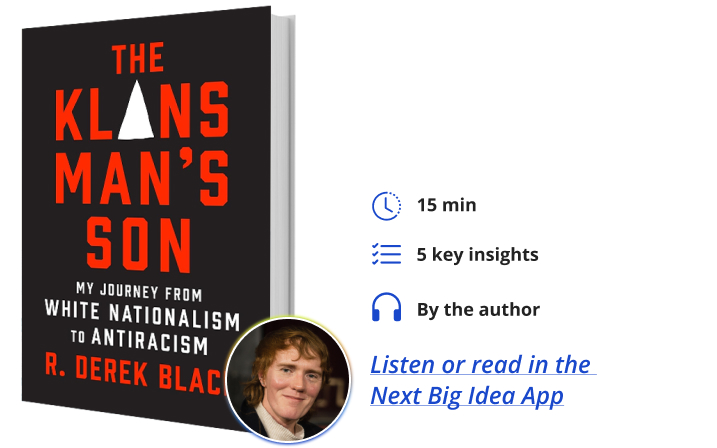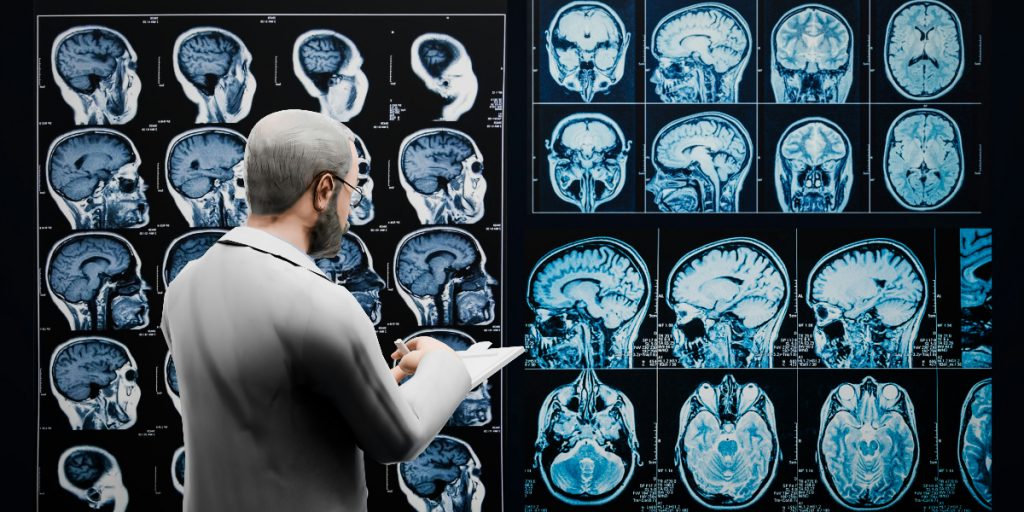Derek Black is an advocate for antiracism and a current doctoral candidate in history. They grew up as the child of two of the central leaders and founders of the American White nationalist movement. They gave national interviews with their father before reaching adolescence, advocating for the racist and antisemitic cause. By the time they went to college, Derek was an international spokesperson for the movement and a presumed leader-in-waiting. In college, however, they spent several years engaging with this new community and was changed; they came to condemn the beliefs they grew up in and has spent the decade since graduation advocating against the movement Derek was once expected to lead.
Below, Derek shares five key insights from their new book, The Klansman’s Son: My Journey from White Nationalism to Antiracism. Listen to the audio version—read by Derek themself—in the Next Big Idea App.

1. The role of ideology and a person’s foundational belief is to reaffirm their identity and community connections.
I recognized this fact only after leaving the movement I’d grown up in. What kept people in an ideological community, which brought them so much social stigma and criticism, was the feeling of being supported by the loyal community that reaffirmed their identity. New followers often showed up with common, and therefore less extreme, racist views. What reaffirmed them was the bonds they formed. It was a movement that defined membership through demonstrations of ideological commitment and familiarity with the movement’s history and symbolism. Learning the arguments that White nationalists used to describe their all-encompassing view of the world became the measure of inclusion in the community.
No one saw themselves as doubling down and amplifying these racist and antisemitic views out of a shallow desire to fit in or to justify the inequality they benefited from. Instead, they spent nearly all their time justifying their beliefs with false science, inaccurate historical arguments, and anecdotal experiences. Over time, becoming members of this marginalized movement marked them as people who saw themselves standing against mainstream society. Their identities became defined by collective resentment and a shared understanding of who their enemies were. No evidence could reach them, not because they were uneducated or ignorant, but because their sense of identity and community relied on their continued belief in the cause.
2. Persuading anyone to change their beliefs about something fundamental to their identity is the same as asking them to change their community.
Only once I had condemned the movement I was raised in could I finally see what seems obvious in retrospect. It was only after I no longer believed in the supposed evidence for racist beliefs that I was forced to admit it was the fear of losing all the connections, care, and love I’d known until my early twenties that kept me from following my values and condemning their beliefs.
“Only once I had condemned the movement I was raised in could I finally see what seems obvious in retrospect.”
I had arrived at college believing I was someone who followed evidence and did not reject anyone simply because of who they were. That led me to develop deep relationships with students of color and Jewish students. Although I didn’t immediately abandon my exclusionary worldview, it was the process of navigating that contradiction of loving this new community and also being someone who caused them pain that opened me to finally hearing and truly considering the plentiful and rigorous counter-evidence to racist beliefs.
3. Our values are more fundamental and consistent to our sense of identity than the specific facts that we believe.
Too often, we imagine that changing someone else’s mind is foremost a process of arguing with them and convincing them to accept better evidence. My life experiences have taught me instead that, while evidence and reason are important in that process, changing what facts we believe is much easier than changing what communities we identify with. Our values drive how we interact with others, whether we see ourselves as loyal friends, seekers of knowledge, reliable partners, or any other list of things at the core of our sense of self. We adopt our worldviews, decide what’s true or good evidence—and sometimes fundamentally change our minds about both things—based on who we feel responsible for and connected to. But we allow ourselves to become connected, feel responsible, and love or reject others by following our values.
The White nationalist movement demands ideological conformity from people who generally see themselves as independent thinkers, loyal friends, and moral absolutists. What often unites them, even if they might not put it this way, is that they have seen the unequal society they were born in and refused to look away. Unlike antiracists, who choose to act to dismantle that unfairness, White nationalists seek with all their being to justify the hierarchy. They refuse to believe the reason people who are seen as White receive more status, resources, respect, or safety is because of a social crime. Instead, they seek out a community that tells them that crime is just and offers them supposed evidence to support that belief.
4. Antiracism is a harder thing to argue for than White nationalism because it demands that people not accept the status quo.
My dad often repeated the mantra that the members he was looking for weren’t necessarily extremists or militants. He wanted people who started sentences with the phrase, “I’m not a racist, but…” Whatever it was they said next was the seed of a much more extreme belief that would make them feel at home in his community. The most effective pitch for White nationalist beliefs was always one that told people they did not need to feel guilty for being the beneficiaries of an unequal society. More than anything else, White nationalists told White people that calls of racism were nothing more than jealousy or hatred being expressed towards them as White people.
“The most effective pitch for White nationalist beliefs was always one that told people they did not need to feel guilty for being the beneficiaries of an unequal society.”
Antiracism, on the other hand, is a belief system that is much more humane. Instead of justifying or advocating for separation, it is a worldview that constantly seeks to expand the circle of people so that anyone can find connection, value, and loyalty. Despite that humane aspect, it is a harder thing to advocate for than segregation and justifications of inequality ever felt. Antiracism asks people to change constantly, to spend their lives trying to find new forms of connection with an ever-expanding group of people. It can be overwhelming. It is not less natural than the fear peddled by racism, but it can feel more risky to ask people to imagine something that does not yet exist.
5. To change someone’s mind on something core to who they are, you must first be able to argue it as well as they can.
The context of widespread campus outrage from a small community I knew personally opened me up to asking the question, “Where is the misunderstanding?” I did not want to see myself as someone intentionally causing harm to people I cared about. Yet it was ultimately years of intense conversations in private that allowed me to accept there was no misunderstanding other than my own. I was only able to have those conversations in dorm rooms, on walks, and in long car rides because I was talking to someone who had become a specific person in my life.
I had spent my entire life among a community of people who said everyone else in the world didn’t understand us. My experience at college was not one of hearing that racism was bad for the first time. Instead, it was the first time I felt like I could no longer fall back on the belief that the people on the other end of that message didn’t understand me or my beliefs. Instead, after hearing me out over months, that specific person could recite what I believed as well as I could, and yet she also was clear that she believed it was wrong on every level. It is a rare quality in someone to be able to sit with that level of dissonance to know and love someone who you fundamentally abhor the beliefs of. Yet that is what is necessary to be able to engage on that level of change.
To listen to the audio version read by author Derek Black, download the Next Big Idea App today:































